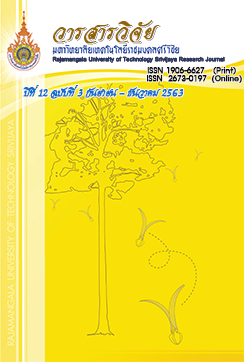Isolation of Secondary Metabolites-Producing Endophytics and Free Living Microorganisms from Sea Active against Methicillin-Resistant Staphylococcus aureus
Keywords:
Staphylococcus aureus, methicillin, secondary metabolites, bioactive compounds, endophyticsAbstract
This study is a part of drug-based screening from natural products. The sponges and mud from the sea were randomly collected for antibiotic-producing bacteria isolation. The bacterial isolates mud from the sea and endophytic from sponges found on Ko Sarai area, Satun province. They were tested for antibiotic-sensitive bacteria (Staphylococcus aureus TISTR517) and methicillin-resistance bacteria (Staphylococcus aureus MRSA142). Double layer overlay and agar well diffusion methods were tested. From the experiment, 11 isolates bacteria were separated from the endophytic group that covered the surface of the sponge and free-living bacteria groups. The morphology of isolated bacteria showed embedded colony which acted as Actinomycetes. Isolated bacteria code S6.2 and SK3 showed antimicrobial against two bacterial strains tested. This research may be useful for methicillin resistant antibiotic studies in the future.
References
Blunt, J.W., Copp, B.R.M., Munro, M.H.G., Northcote, P.T. and Prinsep, M.R. 2004. Marine Natural Products. Natural Product Reports 21: 1-49.
Colwell, R.R. 2002. Fulfilling the Promise of Biotechnology. Biotechnology Advances 20: 215-228.
Dechsakulwatana, C. and Putchakarn, S. 1998. Research Report on Studies on Bioactive Metabolites from Marine Bacteria which Associated with Thai Sponges. National Research Council of Thailand. (In Thai)
Ely, R., Supriya, T. and Naik, C.G. 2004. Antimicrobial Activity of Marine Organisms Collected of the Coast of South East India. Journal of Experimental Marine and Ecology 339: 121-127.
Fenecal, W. and Jensem, P.R. 1993. Marine microorganisms: A new Biomedical Resource, pp. 500. In Attaway, D.H. and Zaborsky, O.R., eds. Marine Biotechnology, I. Pharmaceutical and bioactive natural products, Plenum press, New York.
Friedrich, A.B., Markert, H., Fendert, T., Hacker, J., Proksch, P. and Hentschel, U. 1999. Microbial Diversity in the Marine Sponge Aplysina caverniucola (formerly Verongia cavernicola) Analyzed by Fluorescence In Situ Hybridization (FISH). Marine Biology 134: 461-470.
Gandhimathi, R., Arunkumar, M., Selvin, J., Thangavelu, T., Sivaramakrisnan, S., Kiran, G.S., Shanmughapriya, S. and Natarajseenivasan, K. 2008. Antimicrobial Potential of Sponge Associated Marine Actinomycetes. Journal of Medical Mycology 18: 16-22.
Groombridge, B. 1992. Global Biodiversity: Status of the Earth’s Living Resources. Chapman and Hall, London.
Menezes, C.B., Bonugli-Santos, R.C., Miqueletto, P.B. Passarini, M.R., Silva, C.H., Justo, M.R., Leal, R.R., Garboggini, F.F., Oliverira, V.M., Berlinck, R.G. and Sette, L.D. 2010.
Microbial Diversity Associated with Algae, Ascidians and Sponges from the North Coast of Sao Paulo State, Brazil. Microbiological Research 165: 466-482.
Prapaiwong, A. 2012. Isolation of Bacteria with Antimicrobial Activity from Marine Invertebrates. Thesis for the Degree of Master of Science in Microbiology. Department of Microbiology, Faculty of Science, Prince of Songkla University.
Proksch, P., Edrada, R.A. and Ebel, R. 2002. Drugs from the Sea-Current Status and Microbiological Implications. Applied Microbiology and Biotechnology 59: 125-134.
Shetty, P.R., Buddana, S.K., Tatipamula, V.B., Naga, Y.V.V. and Ahmad, J. 2014. Production of polypeptide antibiotic from Streptomyces parvulus and its antibacterial activity. Brazilian Journal of Microbiology 45(1): 303-312.
Wilson, J.E. 1988. The Systematics’ Perspective, pp. 1-6. In Fautin, D.G., ed. Biomedical Importance of Marine Organisms. California Academy of Science, San Francisco.
Downloads
Published
How to Cite
Issue
Section
License
The content and information in the article published in Journal of Rajamangala University of Technology Srivijaya It is the opinion and responsibility of the author of the article. The editorial journals do not need to agree. Or share any responsibility.







